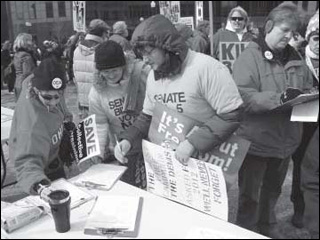How Labor Won in Ohio
How Labor Won in Ohio
Courtney Johnson, who has taught English in Ohio high schools for a decade, never expected to make news. In her classes, she routinely stressed the importance of civic participation and political awareness. As adviser to the school newspaper, she emphasized the art of balanced and nuanced reporting on complex issues.  But until 2010, Johnson’s own political activities were too minimal to bring up in school.
But until 2010, Johnson’s own political activities were too minimal to bring up in school.
Then everything changed. John Kasich, a former Republican congressman and Fox News commentator, ran for governor of Ohio and declared war on the teachers’ unions. They were, he claimed, “more concerned with their own situation rather than the situation of our children.” Kasich pledged to “break the back of organized labor in the schools.”
Johnson leapt into action. “Leading into the election, I remember I posted to my Facebook page, ‘Please pay back a public school teacher in your life by voting for [Democratic incumbent Governor Ted] Strickland.’” Johnson had been marginally involved in her local affiliate of the National Education Association (NEA). But after Kasich was elected and made good on his threat to try to destroy the collective bargaining rights of Ohio’s public workers through Senate Bill Five (SB5) Johnson found herself on the front lines of the fight to defeat it.
Johnson joined We Are Ohio, the coalition formed to fight SB5. We Are Ohio was opposed by Building a Better Ohio, a political action group backed by Republicans, business interests, and Tea Party activists. We Are Ohio submitted more than a million valid petition signatures to place repeal on the November 2011 ballot, almost quadruple the required number. On Election Day, repeal won with 62 percent and 2.1 million votes. It carried majorities in eighty-three of Ohio’s eighty-eight counties. Most of the labor was performed by volunteers like Johnson.
The labor-liberal coalition’s unequivocal victory in Ohio stands in contrast to the results of campaigns in other Midwestern states, such as Indiana’s quiet passage of a right-to-work law last February. Protesters of the 2011 Wisconsin law to limit the collective bargaining rights of public sector workers have generated enormous news coverage, but state senatorial recall efforts failed to create a Democratic majority. (At this writing, the results of the June recall are not known.) Unionization and public attitude toward unions both remain low, and the recession and slow recovery have provided cover for attacks on organized labor around the country.
But the wide margin of victory in Ohio shows that labor can mount a successful defense.
We Are Ohio was successful because it assembled a true coalition of Democrats and Republicans, unionists and nonunionized workers, those hailing from union strongholds like Toledo and conservative regions like Butler Count...
Subscribe now to read the full article
Online OnlyFor just $19.95 a year, get access to new issues and decades' worth of archives on our site.
|
Print + OnlineFor $35 a year, get new issues delivered to your door and access to our full online archives.
|






